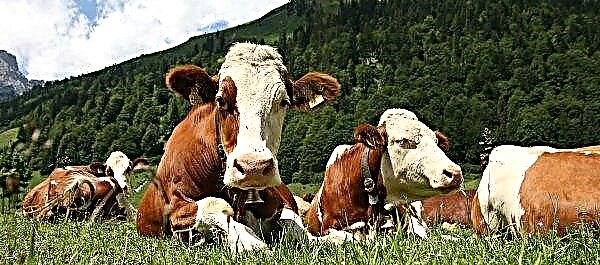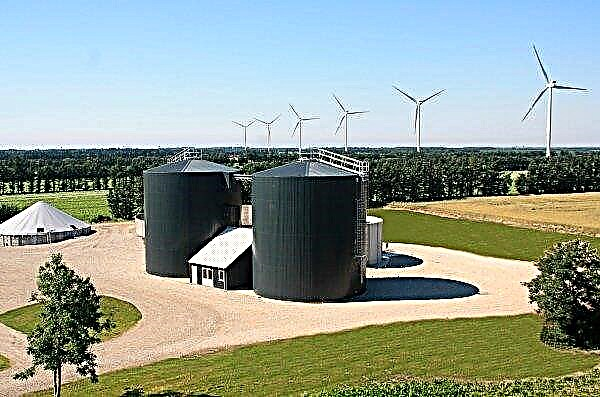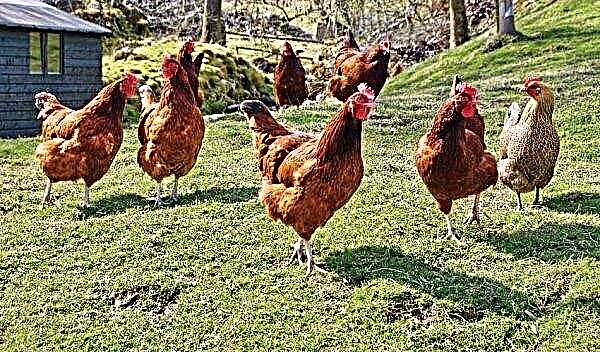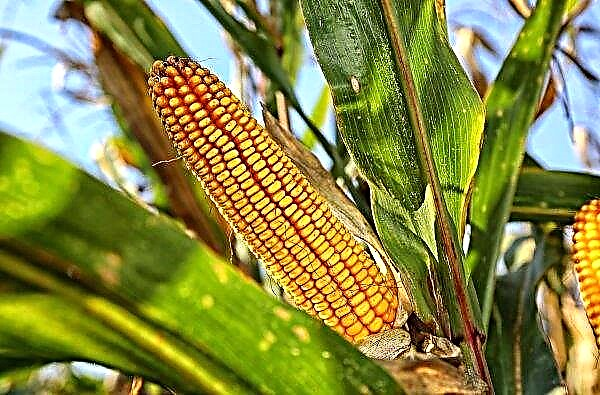A beautiful lawn helps to hide the flaws and emphasize the advantages of the garden. The most attractive characteristics are universal roll grass. How to properly break such a lawn in the area and take care of it, read below.
Properties and characteristics of a universal lawn
First of all, you should study in detail the information about what a rolled lawn is and for what purpose it is suitable. This will allow you to correctly schedule agricultural activities and prevent mistakes in the future. The universal rolled lawn is designed not only for decorative purposes, but also is great for active mechanical use (walking, playing sports, placing garden furniture, etc.). It got its name due to the possibility of using various types of herbs. Such a lawn can be sown independently or you can buy a ready-made roll in the store.
The universal rolled lawn is designed not only for decorative purposes, but also is great for active mechanical use (walking, playing sports, placing garden furniture, etc.). It got its name due to the possibility of using various types of herbs. Such a lawn can be sown independently or you can buy a ready-made roll in the store.
Did you know? A well-equipped lawn is a better generator of clean air than trees. The whole secret lies in regular haircuts, after which the formation of new greens, which provide large volumes of oxygen production, is accelerated.
The main properties and characteristics of a universal rolled lawn:
| General form | Saturated green color, velvety soft surface, nice texture. It is a bay, cut into strips of 2 m long, 40 cm wide and weighing 25 kg each. |
| Life time | When creating favorable conditions and fulfilling all the rules of agricultural technology - at least 7 years. |
| Lighting | The sun or partial shade, the grass does not grow in absolute shadow. |
| Grass height and root layer length | About 10 cm to 2 cm of roots |
| Average seed consumption | 40 g / m² |
| Survival rate | High (when following the rules of care) |
| Frost resistance | It tolerates frosty winters. |
| Dependence of seed germination on weather conditions | Cold does not affect the rate of seed germination, however, sudden changes in temperature are detrimental to grass. |
Landscape design application
As mentioned above, the purpose of using a universal roll lawn can be very different. In landscape design, it is used to decorate the space around flower beds, houses, recreation areas (both active and passive), as well as alpine slides.

It is important to first familiarize yourself not only with the features and characteristics of a rolled lawn, but also carefully consider its strengths and weaknesses.
- The advantages of this element of landscape design:
- attractive appearance;
- universality in intended use;
- ease of replacing a withered part of the lawn with a fresh one;
- high frost resistance and survival rate.
Rolled lawn is not without flaws.
- These include:
- the need for thorough preliminary soil preparation;
- shorter service life compared to seeded lawns;
- high cost;
- the need to attract specialists, if you need to arrange a large area, otherwise the rolls will begin to wither even before planting;
- decrease in decorative qualities in case of non-compliance with the haircut schedule;
- the inability to place in the shade;
- purchased lawn can not be stored for a long time in a roll, as this has a detrimental effect on the state of greenery and the speed of its survival in the future.
Composition of Lawn Grasses
Lawn mixtures, regardless of whether they are used in rolls or sown independently, are included in the composition of herbs that grow rapidly.
Mainly:
- pasture ryegrass;
- fescue;
- bluegrass;
- timothy.
All of the above herbs require approximately the same care and conditions for growth. They can be presented in different mixtures in distinctive percentages.
Seeding Rules
Universal lawn grass mixtures must be correctly selected and planted. To do this, take into account the timing of landing. Based on these time frames, they determine the period of preparatory work aimed at disinfection and increase soil nutrition. If everything is done right at the initial stage, then positive results will not be long in coming.
Time for sowing
Sowing lawn seeds begins in early May, when night temperatures have time to stabilize and do not fall below + 10 ° C. During this period, the grass is highly germinated. If weather conditions allow, you can perform the procedure at the end of April. In summer, you need to sow the lawn only with an automatic watering system, otherwise it will quickly fade from drought. If this is not possible, it is better to wait until the fall (September - early October). Lawn grass in a roll can be planted from April to September. But it is better to manipulate in the spring. With this approach, before the onset of winter, the vegetation will have time to fully take root and will tolerate frosts well. Preparatory work on the site must begin six months before sowing.
If this is not possible, it is better to wait until the fall (September - early October). Lawn grass in a roll can be planted from April to September. But it is better to manipulate in the spring. With this approach, before the onset of winter, the vegetation will have time to fully take root and will tolerate frosts well. Preparatory work on the site must begin six months before sowing.
Soil preparation
To begin with, the site is cleaned of plant debris, weeds, and roots are removed from the soil. After cultivating the soil to a depth of 40 cm and proceed to disinfection. For this purpose, herbicidal compositions are used - they help to eliminate the likelihood of weed germination on the lawn in the future, which will positively affect the rate of vegetation survival. The Tornado preparation is good for this: it is diluted in a proportion of 75 ml per 3 liters of water, and this solution is enough to process 100 m² of area.
Fluid is sprayed throughout. Three weeks after disinfection, you can begin to enrich the soil with nutrients. In order for the vegetation to develop well, the earth must be loose. To ensure this condition, 20 kg of peat-sand mixture (1: 1 ratio) is added to each 1 m² of area. In parallel with this, manure is also being laid. Based on 1 m², 10 kg of cow or 3 kg of bird droppings are taken. Immediately after the introduction of nutrients into the soil, it is again cultivated. Waterlogged soil can cause the spread of fungal diseases on the lawn. Given this, in low-lying areas, a drainage system should be organized in advance.
In parallel with this, manure is also being laid. Based on 1 m², 10 kg of cow or 3 kg of bird droppings are taken. Immediately after the introduction of nutrients into the soil, it is again cultivated. Waterlogged soil can cause the spread of fungal diseases on the lawn. Given this, in low-lying areas, a drainage system should be organized in advance.
It is recommended to do this as follows:
- Remove 40 cm of fertile soil.
- Place 10 cm of gravel on the site, lay 10 cm of sand on top of it.
- Carefully compact the indicated substrates (this can be done using the roller).
- Return the cut soil layer back, aligning it with the total height of the site.
- Tamp again.
- Check the quality of work performed by standing on any part of the square - if the earth does not settle, then everything is done correctly.
Video: how to properly prepare the territory for a rolled lawn
Seed selection
Buying seeds separately will be much cheaper than a ready-made rolled lawn. However, they will need to be sprouted on their own.
Important! Do not buy seeds in natural markets or by hand. It is better to purchase planting material in specialized stores where you can get advice on its further use and rules of care.
When choosing you should be guided by such criteria:
- expiration date on packaging - until its completion must remain at least 6 months;
- seed bag quality - dry, without vague spots (otherwise we can talk about inappropriate storage conditions of planting material).
Step-by-step sowing instructions:
- Three days before planting, add 40 g of Nitroammofoski to each 1 m² and moisten the area. If the soil does not require watering, then fertilizer should be laid to a depth of 5 cm. This manipulation is conveniently carried out with a rake.
- Mix the seeds, then divide the entire volume into four equal parts.
- Separate square zones on the site. This can be done by driving the stakes at an equal distance from each other around the perimeter. Then between them you need to pull a wire or thread.
- Distribute the seeds in each square, scattering them “crosswise”.
- To process the planting places with a rake, leveling the seeds on the site.
- Cover the area with a mixture of 10% sand, 30% peat and 10% compost.
- Water the area from the sprayer and then cover with a transparent film so that the birds do not glue the seeds.
 With the advent of the first shoots (after about two weeks), the shelter can be removed. During this time, it should be removed for a couple of hours daily to air the plantings and, if necessary, carry out hydration.
With the advent of the first shoots (after about two weeks), the shelter can be removed. During this time, it should be removed for a couple of hours daily to air the plantings and, if necessary, carry out hydration.
Laying the finished roll lawn
With a ready-made rolled lawn, you need to behave very carefully. You need to buy it only after the entire area has been prepared. It should be planted on the day of purchase.
Important! Buying a rolled lawn, roll out each bay and evaluate the condition of the grass cover. It should be everywhere the same height, without bald spots and not lag behind the soil layer when trying to pull on yourself.
Step by step instructions for laying a lawn roll:
- You need to start work from the corner of the plot. Better with the one in which the bays are folded - this way you can avoid unnecessary transportation of material, accompanied by shedding of soil and trauma to the roots.
- Lay one roll, clearly aligning it at an angle, and roll it in a straight line. If there is a flowerbed along the roll line, then the bay is laid directly on it, and then the excess is cut off. Thus, the entire first row is lined.
- As soon as the initial row is laid, it needs to be leveled, having slightly adopted the board.
- Next, you should run a hand through the grass to reveal hills or pits. If there are irregularities, then a layer of grass is lifted and the excess soil removed.
- Having rolled out the initial row, lay a layer of boards on top of the grass. It will be possible to stand on this flooring to continue work.
- Next, the placement of the rolls is carried out on the principle of brickwork. This means that the second and all subsequent rows in the upper part should be placed with joints in the center of the previous ones. The grass cover can evenly take root, and there will be no bald spots in the future (laps cannot be laid out).
- The distance at the joints should be no more than 1.5 cm.
- The weak point on the rolled lawn is the edges. To spread the borders, do not take trimmings with a width of less than 1 m. Such pieces are best placed closer to the center of the square.
- At the end of the work, irrigate the site.
Video: Proper Laying of a Lawn Roll
Care
It is very easy to grow lawn grass.
The main care measures are to carry out activities such as:
- watering;
- fertilizer application;
- regular haircut.
If you follow all the requirements, the lawn will always look good. In addition, the correct approach to growing ensures the durability of the coating and eliminates the need for constant treatments against diseases and pests, since most fertilizing plays the role of not only nutrition of the soil, but also preventive measures against various ailments.
Watering
During the first two weeks after laying the rolls, watering is carried out daily in the morning or evening hours. Water consumption - 10 l per 1 m². For a month after spreading the lawn should not walk on it. Further watering is carried out once every 10 days. It is best done using automated spray guns.
Top dressing
In order for the grass to maintain its saturated color and grow well, it needs fertilizers. Make them at least three times for the entire season. It is possible more often, but everything will depend on the type of top dressing and its composition.
Fertilizer schedule for universal lawn:
- When the temperature has reached positive temperature in the course of two months, Bona Forte is added every two weeks. It is dissolved in water at the rate of 80 ml per 12 liters. This is enough to handle 6 m². If there is not much time or just do not want to fertilize often, you can use urea. It is taken at the rate of 40 g per m². This amount of fertilizer is dissolved in 10 l of water.
- At the end of June, you can use the "Nitroammofoska" - 40 g per 10 liters of water. This is enough for 1 m² of area.
- In July and August, potassium salt is added. It is scattered over the site at the rate of 20 g per 1 m² and irrigated. If the summer is too rainy, then the rate of application of this element is increased up to 4 times, since it is potassium that is quickly washed out of the soil.
- In the autumn, two weeks before the first frost, 70 g of double superphosphate are added for every 1 m² of area. This amount of substance is diluted in 10 liters of water.
Did you know? The first lawn mower was created by the English inventor Edwin Beard, and as a prototype a machine was taken to trim the edges of fabric rolls. A patent for mass production was obtained by him in 1830.
A haircut
The more often the haircut will be carried out, the more beautiful and neat the lawn will look. After laying, the first such manipulation is performed after four weeks. At this stage, you should try to cut off only the tops by 2 cm. All subsequent haircuts are made as necessary when the cover reaches a height of 8-12 cm. Mowing after irrigation or rain is impossible, since there is a high risk of damaging the grass that is in the soaked soil, and uproot it. At the end of the procedure, on the contrary, you need to moisten the vegetation profusely. Before the cold weather begins, it is necessary to organize the mowing so that the grass can grow to a height of 4–6 cm until the frost. The universal roll lawn has an attractive appearance and relatively unpretentious care. Although this element of landscape design has its own nuances, they can be easily fixed by observing the basic rules of agricultural technology. And even if bald spots appear in one of the sections of the lawn, you can easily replace the damaged roll with a new one.
Before the cold weather begins, it is necessary to organize the mowing so that the grass can grow to a height of 4–6 cm until the frost. The universal roll lawn has an attractive appearance and relatively unpretentious care. Although this element of landscape design has its own nuances, they can be easily fixed by observing the basic rules of agricultural technology. And even if bald spots appear in one of the sections of the lawn, you can easily replace the damaged roll with a new one.












